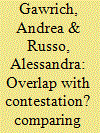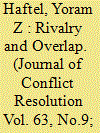| Srl | Item |
| 1 |
ID:
153707


|
|
|
|
|
| Summary/Abstract |
Two sets of regional organizations contribute to the overlapping regionalism in the former Soviet space. On one side we find the Organization for Security and Co-operation in Europe (OSCE) and the Council of Europe (COE), whose original ‘Cold War agenda’ was to enhance the political dialogue across the East–West divide in Europe. On the other side is a kaleidoscopic group of organizations which have been established in the framework of (re-)emerging ambitions of regional leadership, if not hegemony, whose creation has been often interpreted in ‘reactive’ terms, to counterbalance Western influences and projects in the Eurasian geopolitical theatre. The article aims at conceptualizing these regional overlaps, focusing on drivers and effects in terms of regional governance in the post-Soviet region. The authors investigate the similarities and contradictions among four organizations (OSCE, COE, Commonwealth of Independent States and Shanghai Cooperation Organization) from the two different organizational sets, regarding leading norms and policies that address both human and security dimensions.
|
|
|
|
|
|
|
|
|
|
|
|
|
|
|
|
| 2 |
ID:
159326


|
|
|
|
|
| Summary/Abstract |
Once considered severely under-institutionalized, East Asia has experienced a rapid process of institution-building since the end of the Cold War resulting in a significant degree of organizational overlap, both in membership and mandate. This paper examines the drivers and potential effects of institutional overlap in East Asia. It argues that the informal nature of Asian institutions coupled with competing visions of regionalism among member states make the region especially prone to overlapping regionalism. The consequences of such overlap for the time being have been positive. However, Asian policymakers must consider issues of institutional design to avoid steering the regional architecture in a direction which fosters regional rivalries and institutional competition in the long run. To illustrate the process of institutional overlap, I draw examples from a sub-set of regional organizations emerging out of the ASEAN family of institutions: the ASEAN+3, the East Asia Summit, and the Trilateral Cooperation Secretariat.
|
|
|
|
|
|
|
|
|
|
|
|
|
|
|
|
| 3 |
ID:
169076


|
|
|
|
|
| Summary/Abstract |
The proliferation and scope expansion of regional organizations (ROs) is one of the most prominent features in contemporary international politics. In particular, many regional economic organizations (REOs) have expanded into the security realm. This trend has often resulted in an overlap with regional security organizations (RSOs) already in place. This study sheds light on this phenomenon by identifying the conditions under which REOs trespass into the security policy domain despite the fact that preexisting RSOs already fulfill security functions. We argue that the presence of strategic rivalries is an important driver of the creation and depth of organizational overlap through scope expansion. Specifically, RSOs that include significant interstate rivalries propel a subgroup of like-minded states to advance and deepen security cooperation through their existing REOs. Using an original data set of security cooperation within economic and security ROs and a quantitative analysis, we find substantial support for this argument.
|
|
|
|
|
|
|
|
|
|
|
|
|
|
|
|